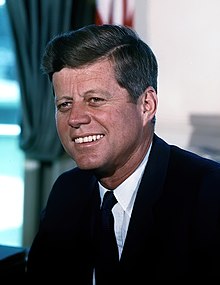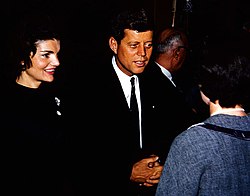 John Fitzgerald Kennedy, widely known as Jack Kennedy, or by his initials JFK, was sworn in as the 35th president of America at noon on January 20, 1961. In his inaugural address he spoke of the need for all Americans to be active citizens, famously saying, "Ask not what your country can do for you; ask what you can do for your country." He asked the nations of the world to join together to fight what he called the "common enemies of man: tyranny, poverty, disease, and war itself".
John Fitzgerald Kennedy, widely known as Jack Kennedy, or by his initials JFK, was sworn in as the 35th president of America at noon on January 20, 1961. In his inaugural address he spoke of the need for all Americans to be active citizens, famously saying, "Ask not what your country can do for you; ask what you can do for your country." He asked the nations of the world to join together to fight what he called the "common enemies of man: tyranny, poverty, disease, and war itself".He added: "All this will not be finished in the first one hundred days. Nor will it be finished in the first one thousand days, nor in the life of this Administration, nor even perhaps in our lifetime on this planet. But let us begin." In closing, he expanded on his desire for greater internationalism: "Finally, whether you are citizens of America or citizens of the world, ask of us here the same high standards of strength and sacrifice which we ask of you."
Kennedy defeated Vice President and Republican candidate Richard Nixon in the 1960 U.S. Presidential Election. At age 43, he was the youngest to have been elected to the office, the second-youngest president after Theodore Roosevelt, and the first person born in the 20th century to serve as president.To date, Kennedy has been the only Roman Catholic president and the only president to have won a Pulitzer Prize.
 |
| Jackie with Jack campaigning in Appleton,Wisconsin, March 1960. |
Kennedy brought to the White House a stark contrast in organization compared to the decision-making structure of former-general Eisenhower; and he wasted no time in dismantling Eisenhower's methods. Kennedy preferred the organizational structure of a wheel, with all the spokes leading to the president. He was ready and willing to make the increased number of quick decisions required in such an environment. He selected a mixture of experienced and inexperienced people to serve in his cabinet. "We can learn our jobs together", he stated.
Kennedy was taken to Parkland Hospital for emergency medical treatment, but pronounced dead at 1:00 pm. Only 46, President Kennedy died younger than any other U.S. president to date. Lee Harvey Oswald, an employee of the Texas School Book Depository from which the shots were suspected to have been fired, was arrested for the murder of a local police officer, and was subsequently charged with the assassination of Kennedy. He denied shooting anyone, claiming he was a patsy, but was killed by Jack Ruby on November 24, before he could be tried. Ruby was then arrested and convicted for the murder of Oswald. Ruby successfully appealed his conviction and death sentence but became ill and died of cancer on January 3, 1967, while the date for his new trial was being set.
 |
| President Kennedy's family leaving his funeral at the U.S. Capitol Buildin |
A Requiem Mass was held for Kennedy at the Cathedral of St. Matthew the Apostle on November 25, 1963. Afterwards, Kennedy's body was buried in a small plot, (20 by 30 ft.), in Arlington National Cemetery. Over a period of three years (1964–66), an estimated 16 million people had visited his grave. On March 14, 1967, Kennedy's body was moved to a permanent burial plot and memorial at the cemetery. The funeral was officiated by Father John J. Cavanaugh. It was from this memorial that the graves of both Bobby and Ted were modeled.
The honor guard at Kennedy's graveside was the 37th Cadet Class of the Irish Army. Kennedy was greatly impressed by the Irish Cadets on his last official visit to Ireland, so much so that Jackie Kennedy requested the Irish Army to be the honor guard at the funeral.
Kennedy's wife, Jacqueline and their two deceased minor children were buried with him later. His brother, Senator Robert Kennedy, was buried nearby in June 1968. In August 2009, his brother, Senator Edward M. Kennedy, was also buried near his two brothers. John F. Kennedy's grave is lit with an "Eternal Flame". Kennedy and William Howard Taft are the only two U.S. presidents buried at Arlington. According to the JFK Library, "I Have a Rendezvous with Death", by Alan Seeger "was one of John F. Kennedy's favorite poems and he often asked his wife to recite it".



No comments:
Post a Comment